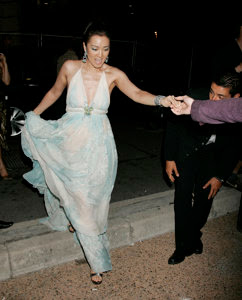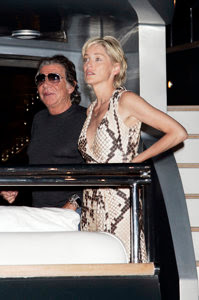The ideal situation for journalists would to be totally independent and non-partisan and just record and report the news.
In the real world that almost never happens.
One of my first jobs I was reminded by the editor-in-chief that a newspapers was a business and the our number one job was to sell newspapers. My idealistic view of the journalists being integral to a free society, the fourth estate, freedom of speech, voice of the people, was shattered.
How do the demands of fair and balanced reporting relate to the business side of selling newspapers? There is supposed to be this imaginary wall dividing the editorial side and the business side of things in journalism. The problem is the wall is like the emperor's new clothes, and not all that well built.
I have worked at small, medium and large newspapers. The one thing I was never handed was any thing relating to ethics. Nothing on what you could do or not do. Actually, I never held a job where ethics were spelled out. What are the rules? Are there no rules?
There is a telling scene in the first episode of "The Sopranos" this season. Tony Soprano, his sister and brother-in-law are playing Monopoly. All of sudden new rules are implemented. Tony's brother-in-law objects, citing the official rules in his protest, but to no avail. I remember the exact same thing happening when I was in the fourth grade. My friend made up the rules as we went along, eventually I learned what the rules were. I have had similar experiences in journalism.
One of the first rules of a newsphotographer is that you never manipulate people for photos. You are supposed to capture what is in front of you and by doing so, have truthful images. When I was a young teenage photographer shooting for my college student newspaper, "The Spectrum" in Buffalo, NY, that's what I did. I was so shy I couldn't do anything else. I didn't know how to direct someone to do something to make a photograph more interesting.
Then one day I covered an event that the mainstream press covered. The veteran newspaper photographer who showed up probably didn't even know I existed. He staged and directed people and was in and out of the event in no time. Was he unethical? His boss wouldn't have thought so. This is how things were done. And in most cases still done at big and small newspapers and other news organizations across the country. I have seen it first hand.
The second rule is that you don't manipulate the image after the fact. You know, photoshop it. It's funny that a software program is now a verb in the mainstream.
Back in the day of no computers, we made black and white prints. We darkened and lightened selected areas of the print in the darkroom. We rubbed ear wax on the negative to get rid of scratches. We used bleach to whiten someone's eyes or open up shadows.
Some photographers went a little too far. They had hockey pucks and balls that could be placed in a photo. They combined negatives. They darkened areas from pure white to pure black. It was called "hand of God" printing. The practice not only was accepted, it was encouraged, many award-winning photo used its methods.
Photographers tried to grandfather techniques from the old days, stating that Photoshop could only be used to replicate a darkroom print. Really?
It's pretty easy to change a photograph. Clone out something. Add something. A photographer who grew up learning from the veteran shooters who rules were that they were no rules, not only be tempted to change things radically to make a perfect photo, it would be like leaving the cars to the Porsche on the kitchen counter while you left on a two week vacation with your teenagers in charge. Wanna bet the Porsche has some uneven wear on the tires when you come back?
This is a typical day for a working photographer on a small to mid-size newspaper. Four to six assignments ranging from a feature portrait, a sporting event, a craft fair and a couple shots of features of people doing stuff that can be used anywhere in the newspaper. Some newspapers call it "wild art", enterprise feature, a standalone, and I even heard the term "rope" a take on the acronym ROP which means run of press. Pretty boring stuff. From this you have to make photos that make readers want to read the stories. For a photographer you also want to make photos that will be in your portfolio so you can land that bigger and hopefully higher paying job.
My first full-time job paid $280 a week. I worked 6 days a week and 14 hours a day. The minimum wage at the time was $4.00 an hour. The newspaper did not pay overtime. So basically the guy at the local fast-food joint was making more money and he didn't have to own expensive camera equipment, drive his own car or have a college degree. I had to fill a whole newspaper with photos. Front page, sports page, feature pages, local pages, special sections, a couple of photo pages a week, plus process and print all the reporters photos, and make prints for the public who saw their photo in the newspaper and wanted copies. Oh and by the way I was also in charge of ordering photo supplies, fixing and maintaining all photo equipment and trouble shooting the computer equipment at the newspaper.
With all that on tap, do you think ethics was a topic of discussion in the newsroom. Most reporters had a bottle of booze in their desk drawer and you couldn't see the other end of the newsroom because of the haze from cigarette smoke. That was 20 years ago. Okay, they banned drinking and smoking in the newsroom, but have things really changed? I know of one reporter who works out of a bar to circumvent the drinking and smoking rules. Ethics? This guy works out of a bar, so I guess bar rules apply.
There are some great photographers who have the backing of there news organization to put in the long hours to document incredible story-telling photos. Unfortunately with the down-sizing of newspapers and other new gathering operations, that has become a luxury. It's very difficult and expensive to cover stories that are important. The pressure to get those same photos in a few hours or minutes that should take days or months has lead to questionable means to get them.
Editors never ask how? They ask why not? Like, why did you not get that shot? The other newspaper has it. Why is that photo so boring? They never ask, did you manipulate the subject to get that great photo? It's the don't ask, don't tell policy. Editors don't really want to know.
Here is some of the answers they would get from some photographers if they were given truth serum.
- I drove two hours looking for a feature and I saw these kids playing and they stopped when I got out of the car so I told them to redo the thing so I could get a photo. The last time I didn't get the feature, you yelled at me so I took things into my own hands.
- I had two minutes for the photo and I missed the distracting thing in the background so I cloned it out.
- I was told to get a picture of holiday traffic, but I couldn't find any so I used a long lens to make it look a lot worse that it really was.
- The only place there was flooding was in this one area so I went there and got a low angle to make it more dramatic, plus the story was on how bad the flooding was.
- I was late for the event with all the other assignments, so I had them re-create the event.
You get the idea.
So why are ethics important? A news photograph represents truth. Do you want a lie? Are you happy to pay for a premium product and to later find out it's a knock-off, a fake? The box shows a photograph of a mouth-watering steak dinner, inside it's a frozen mass of brown. Mission Accomplished? Jessica Lynch a hero? We make life changing decisions based on photos. The photo of that cute person you met online, it has been retouched. That beautiful house you saw on the internet, they didn't show you the termites in the basement? The elected official doing....oh forget it, it was a photo-op. Jaded, cynical? Men didn't land on the moon? The Holocaust didn't happen? Every photo is a fake? What and whom are we to believe?
 Monday, May 21, 2007 at 4:11AM
Monday, May 21, 2007 at 4:11AM  Cannes - Owning a yacht at the Cannes Film Festival is key to meeting people. You can attract everyone from a major movie star to a horde of photographers. Italian fashion designer Robert Cavalli uses his to entertain his Hollywood clients.
Cannes - Owning a yacht at the Cannes Film Festival is key to meeting people. You can attract everyone from a major movie star to a horde of photographers. Italian fashion designer Robert Cavalli uses his to entertain his Hollywood clients. The deck of a private yacht is also the best way to watch the fireworks at midnight.
The deck of a private yacht is also the best way to watch the fireworks at midnight.









